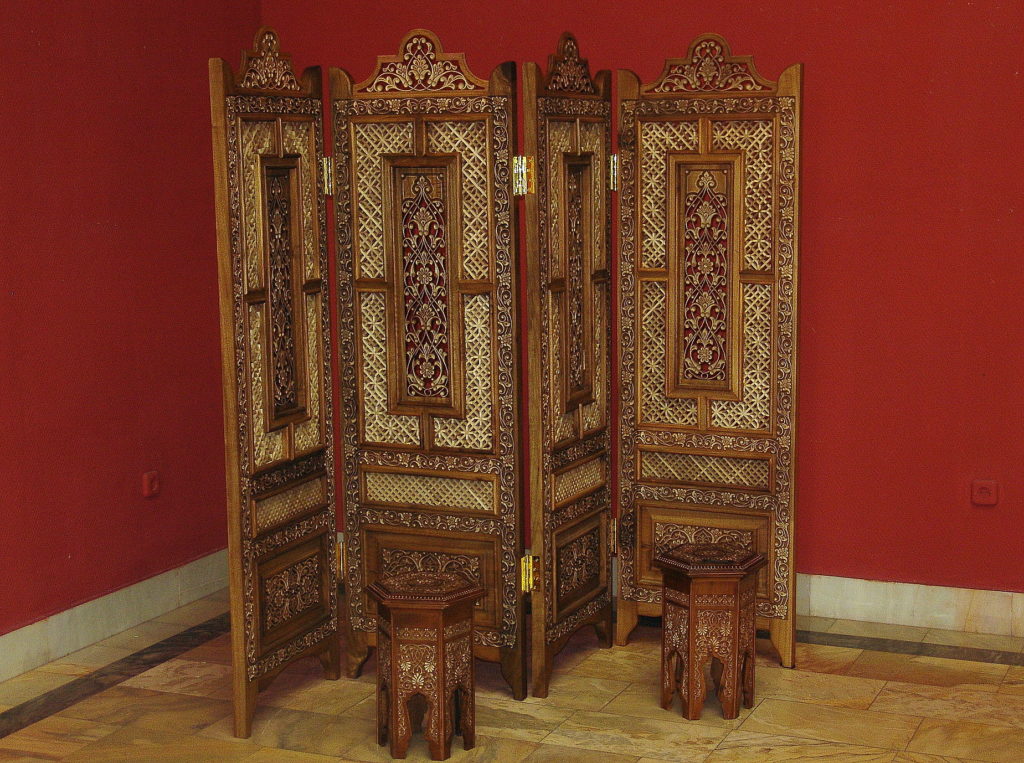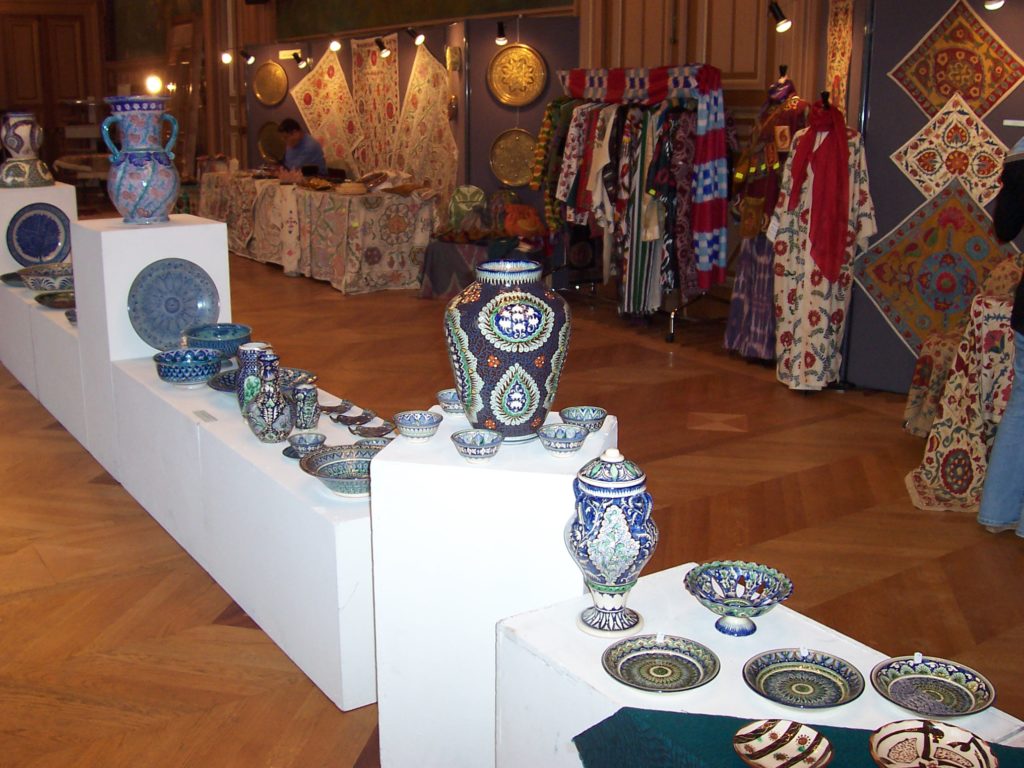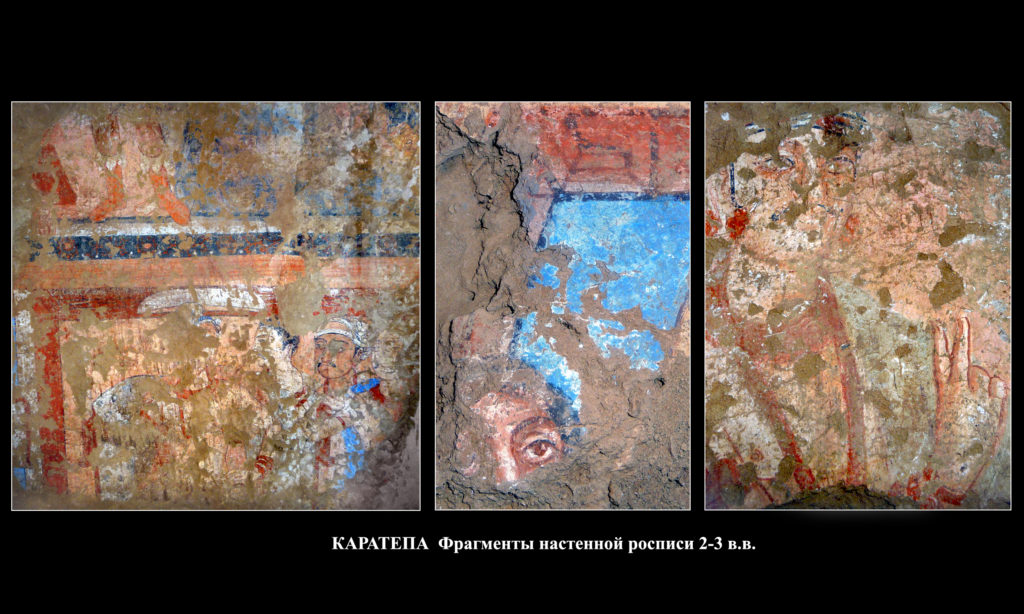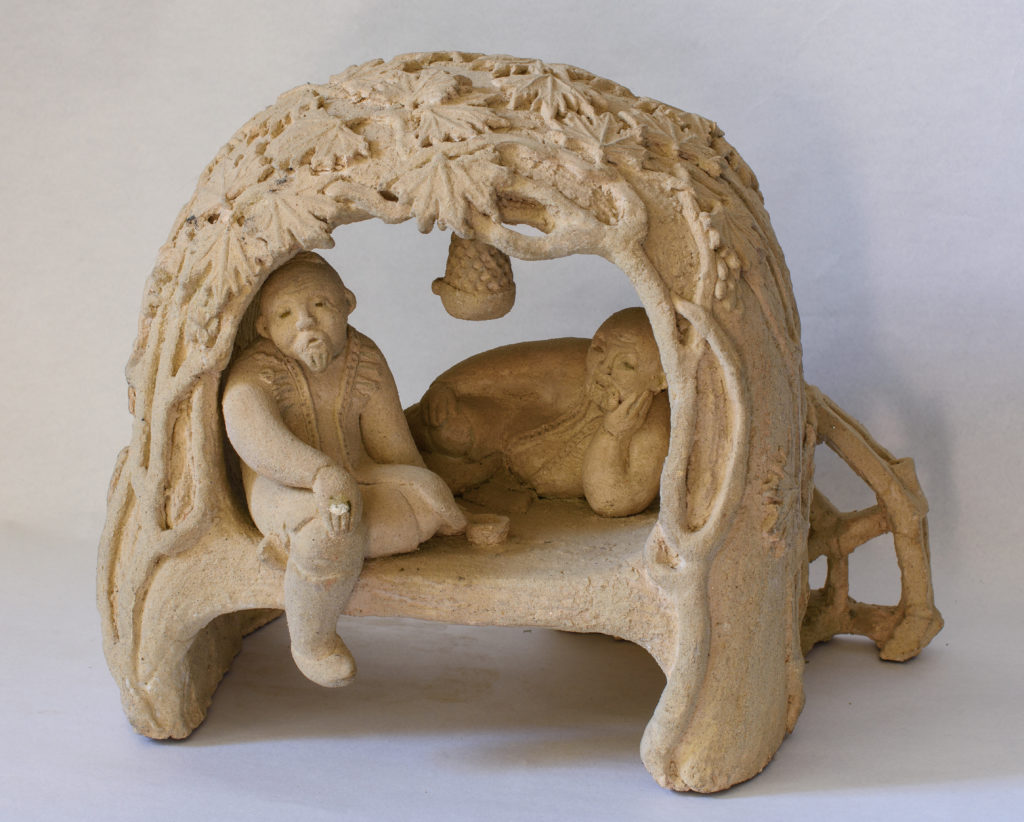Art of Uzbekistan
The art of the Uzbek people has an ancient history going back centuries. The territory of Uzbekistan, which occupies a vast area of the Central Asian interfluve – the fertile valleys of the Oks and Yaksart, since ancient times was inhabited by numerous sedentary and nomadic tribes. In Zarautsay, Teshik-tash, Sarmyshsay, Aman Kutan, rock paintings belonging to the era of primitive society were found. The Amu Darya treasure, now kept in the British National Museum, confirms the existence of highly developed fine art in this area as far back as the Bronze Age. Samples of ritual sculptures, numerous terracotta figurines from the sites of Jarkutan, Molallitepa, Sapallitepa and other examples of the fine art of the ancient period on the sites of Bactria, Khorezm and Sogd testify to the deep traditions of monumental art and plastics. In the works of ancient art used complex semantics of ornamental, anthropomorphic and zoomorphic nature. They reflected a kind of artistic picture of the world, formed in the world view of the Eastern man. And the coexistence of various religions and cults, including Zoroastrianism, had a decisive influence on the mentality of the peoples of Central Asia.
The epoch of antiquity on the territory of the republic (IV century BC – IV century AD), was marked by the flourishing of architecture, monumental painting and sculpture, jewelry art, small plastics. In the interiors of temples, palaces and castles of the first centuries AD, magnificent specimens of wall-mounted thematic painting and sculpture, made under the influence of Hellenistic and then Indo-Buddhist art (Khalchayan, Fayaz-tepe, Ayrtam, Dalverzin-tepe, etc.) were found.
Religious views in Bactria-Tokharistan were variegated. Different religions and cults coexisted here – Buddhism, dynastic cult and ancient local beliefs. Along with Buddhism, declared at the turn of AD. Kushan ruler Kanishkoy state religion, the local population continued to worship the deities of the East Iranian pantheon.
Perceiving the traditions of Indo-Buddhist iconography and enriched by the achievements of Hellenistic culture, Kushan art became a kind of conductor of this syncretic aesthetics to other adjacent regions (Toprakkala, Gyaurkala in Khorezm)

In general, the development of local art in its interaction with the traditions of the cultures of the countries of the Anterior and Middle East, Ancient Greece and Rome, India, China and the steppe East, which led to a peculiar symbiosis of various religious and artistic traditions, is characteristic of this whole historical epoch.
In the 6th century, with the establishment of the power of the Turkic Kaganate, political, trade and cultural relations between the Sogdian and Turkic people became more active. In art, there is a kind of Turkic-Sogdian symbiosis. Samarkand, Bukhara, the cities of Southern Sogd, Chach, Khorezm are becoming major cultural centers; magnificent palaces and castles (keshk) are being built here, which are decorated with beautiful wall paintings and sculpture. In contrast to the previous period, secular themes come to the fore in the art of the early Middle Ages. The visual art of this time is associated either with a heroic epic or with cults. Painting is distinguished by the complexity of the pattern and plot of the plot, compositional richness and coloristic richness. The main leitmotif of this painting is the struggle against the forces of evil and darkness, embodied in various thematic and plot variations. The plots of the paintings are secular, many themes are drawn from local mythology and epic. The masterpieces of monumental painting in Central Asia can rightly include early medieval paintings of the Tokharistan school in the dekhkan castle Balalyk-tepe (5th-6th centuries), with scenes of feasts of men and women in colorful robes with cups in their hands; wall paintings of Varakhsha, the capital of the rulers of the Bukhara oasis of the 7th-8th centuries, rich in subjects, depicting a king sitting on a throne in the form of a winged camel surrounded by scenes of court life — sacrifices, hunting, entertainment, and epic scenes — the struggle of a hero sitting on an elephant leopards and fantastic animals. The masterpieces of the Sogdian school include the paintings of Afrasiab of the 7th-8th centuries, where in the large hall there are preserved images of the ambassadors with gifts from neighboring principalities and distant possessions, carefully traced robes, rich in ornaments, with drawings of birds and fantastic animals, to the king of Samarkand. in medallions. Sogdian art provides samples of the synthesis of various arts – painting and sculpture.

Early medieval monumental art and sculpture of Uzbekistan in spirit and style are more associated with the previous ancient times than with the subsequent Muslim Middle Ages, although they had a great influence on the subsequent development of Central Asian art.
With the arrival in the region in the VII-VIII centuries. the religions of Islam, the figurative images were forbidden, the wall sculpture and painting are beginning to be destroyed. According to written sources, at the beginning of the VIII century, during the destruction of the Zoroastrian temple in Samarkand, huge wooden idols were burned. Theologians of the 11th-12th centuries, instructing the faithful, called for the destruction of wall paintings with figured images in bathhouses. Monumental painting and sculpture of previous centuries gradually disappear. Fine art gives way to ornamental art, which is becoming one of the dominants of Muslim aesthetics. The visual appearance of the cities has changed. With the introduction of Islam, the nature of architecture is changing, which, in combination with religious prohibitions, has changed the position of sculpture and wall painting. In the XI-XIII centuries. theologians appealed to ban images of animals and people, even in decorating household items and woven goods. At the same time, wall painting and sculpture continued to exist in various cities of Maverannahr as early as the 11th – 12th centuries, although this process was episodic in nature and was associated more with the individual tastes of a particular ruler.
During the reign of Amir Temur and Temurids, a peculiar mural appears – from monumental, with unfolded historical narrative compositions, to more chamber – landscape, decorative images in style, for which the notion of “ornamental painting” is more applicable (in the interiors of mausoleums from the Shahi Zinda, Bibi-Khanym, Tuman-aka in Samarkand, the interior of the mausoleum of Gumbazi Seyidon in Shakhrisabz there are paintings depicting birds, located on the branches of trees, landscapes. Nevertheless, the main element m style of art of the Muslim time becomes ornament of Uzbekistan, which has become an important component of the artistic environment of Muslim cities. He was decorated with both internal and external sides of monuments, giving the landscape and the space of the city corresponds to the ideas of Islam aesthetic image.
In the middle of the 19th century, the traditions of European fine art penetrate into the region— first of all, easel painting and drawing.
The art of Uzbekistan in all modern forms and genres was formed mainly in the twentieth century and is a product of Eurasian thinking. The traditional artistic culture of Uzbekistan, which has several millennia of its development, by the beginning of the twentieth century bore a reflection of the complex historical, geopolitical, ethno-cultural, religious, socio-economic identity of the region. The dynamics of civilized shifts, the great social upheavals of the beginning of the twentieth century created the background for the birth of European forms of art, and this was not a simple mechanical transfer of European or Russian art to the national soil.
Until the mid-20th century, the visual arts of Uzbekistan were represented by the names of Russian artists who came here at different times (an exception is the work of A.N. Volkov – born in Fergana). In the very first works of artists of Uzbekistan at the beginning of the twentieth century, one can see a symbiosis of creative searches brought from European art and the “genetic code” of the eastern artistic worldview. An example of this is the works of A.N. Volkov, A.V.Nikolaev (Usto Mumin), N.Karakhan, M.Kurzin, E.Koravay, U.Tansykbaev, O.Tatevosyan, V.Ufimtsev and other prominent representatives of the “Turkestan vanguard” ”, Beautifully represented in the collections of the Nukus Museum named after IV Savitsky and the State Museum of Art of Tashkent.

In the 1950s, a national school of painting and sculpture was formed, and easel graphics were widely developed. A huge contribution to the formation and development of the art of Uzbekistan was introduced in the period 1941-1945, when art schools were evacuated to Tashkent and Samarkand from Moscow, Kiev and Leningrad. During this period, the exchange of artistic traditions intensified, their mutual influence contributed to the emergence of new trends, forms, methods, means of artistic expression in various types of art, which, in general, significantly strengthened the professional level of skill of Uzbek artists.
By the end of the twentieth century, the art of Uzbekistan, developing along with the art of other Soviet republics, acquired its own bright original language. In the multinational creative team of artists of Uzbekistan, several generations of artists have formed, each of which has made his own unique contribution to the formation and development of a national school. Their names are included in the golden chronicle of the art of Uzbekistan – these are Abdulhak Abdullaev, Chingiz Akhmarov, Varsham Yeremyan, Rakhim Akhmedov, Nigmat Kuzybayev, Mannon Saidov, Nadezhda Kashina, Rashid Timurov, N. Pak, V.Zhmakin, V. Burmakin, R. Charyev, E. Melnikov, Yu. Taldykin, N. Shin, B. Dzhalalov, Z. Umarbekov, M. Kagarov and many others. In their work, the techniques of Western European art organically synthesized with the traditions of oriental ornamentalism.
Independence and state sovereignty became important reforming factors of the new social structure, world outlook of the nation, its culture and art. The symbiosis of national and universal values was proclaimed as the main value reference point of the new cultural policy. These two components gave originality to modern aesthetic searches in the art of Uzbekistan.
During the years of independence, a new surge in national identity took place in Uzbekistan, interest in studying history and literature, in centuries-old cultural traditions and customs, and religion has increased, and various areas of national art and culture are developing. The creation of the Academy of Arts of Uzbekistan, with a wide network of educational institutions throughout the country, the activities of the Creative Association of Artists contribute to strengthening the professional school of craftsmanship. The achievements of the artists of our days are convincing: everything truly beautiful is born on the basis of a deep knowledge of life, the creative development of traditions embodied in the Uzbek classics, on the basis of continuity in the historical development of art.
Modern artistic practice of the Republic of Uzbekistan is rich and diverse. Examples of a truly imaginative word about time and about oneself, plastic, plot, compositional and other ideological and artistic revelations can be found in the creative achievements of such leading masters of our days as painters A.Ikramdzhanov, S.Rakhmetov, R.Gagloyeva, Kh. Mirzaahmedov, V.Enin, A.Alikulov, graphics M.Sadykov, A.Allabergenov, A.Bobrov, A.Ponomarev, A.Mamajanov, V.Apuhtin and others.
The decorative trend develops in the works of painters A. Mirzaev, F. Akhmadaliev, A. Nura, M. Isanov, J. Usmanov, I. Valihodjaeva, I. Shin, V. Chuba, J. Salpinkidi, A. Tyurin. High mastery in the art of sculpture can be seen in the works of D.Ruzybayev, M.Mirtadzhiyev, A.Hatamov, T, Tadzhikhodzhayev, I.Zhabbarova, B.Mukhtarova, M.Borodina, L.Nesterovich, etc.

The search for humanistic values in the art of Uzbekistan in the twenty-first century is harmoniously combined with the search for the expression of national self-awareness, comprehension of one’s own unique historical and cultural traditions, original artistic “picture of the world” and philosophy, poetics of the East. Moreover, it is transmitted through the language of avant-garde, postmodernism, which today are not just styles and trends of Western art, but become transnational forms of artistic expression of modern art, understood in various parts of the world. It is not by chance that the works of artists of Uzbekistan are highly appreciated by the audience at exhibitions in the republic and at numerous international exhibitions.
Nevertheless, there are a number of problems in the field of artistic creativity that are to be solved in the near future – the construction of new museum and exhibition objects for the existing extensive collections, their popularization in publications, the replenishment of museum collections, the creation of an electronic database, and so on.
Due to a number of objective economic reasons, the visual arts of Uzbekistan, as opposed to folk arts and crafts, have not yet received state preferences – tax incentives, etc., and the work of artists of Uzbekistan currently needs support and is waiting for its investors




